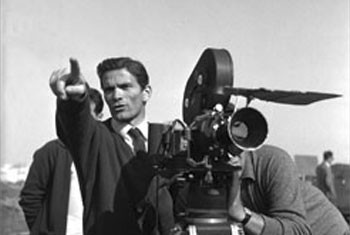Pasolini Roma
22 May - 15 Sep 2013
PASOLINI ROMA
22 May - 15 September 2013
For Pasolini, Rome was not just a stage set or a simple place of residence. Rome had a physical, carnal and passionate existence, as much for the man as for the writer, the poet and the filmmaker. His encounter with Rome was for the author like a great love story, with all its disappointments, its traditions and its mixed feelings of passion and hatred, phases of attraction and phases of rejection, of distancing and return.
For Pasolini the polemicist, the analyst of the evolution of Italian society, Rome constituted his main space for observation, his permanent field of study, reflection and battle. It was based on the changes of this city that he so loved, that he analysed the changes of the Italy and the Italians of the 1960s and 1970s.
There is a Rome before and a Rome after Pasolini. His texts and his films created a new imaginary of the city of Rome. Pasolini was not happy with integrating the city as a backdrop to his novels and his films, but rather he “re-founded” Rome through literature and film. As the great creator that he was, he conceived a new myth of this Vatican and political city, of its neighbourhoods and its inhabitants. Petroli, his last great literary work, unfinished due to his murder, constitutes the last written text of this myth.
Thus, approaching Pasolini through his relationship with the city of Rome means simultaneously entering into all the aspects that composed it and defined it: friendship, literature, politics, love, sex and film.
The intention is not to produce a commemorative exhibition that looks at the past. This is an exhibition that is situated in the present. The beauty and density of the original material presented will highlight the testimony and creativity of Pasolini. It will feature hand-written film manuscripts full of annotations, correspondence (with other intellectuals and artists), drawings and paintings produced by Pasolini, photographs, films, fragments of interviews, etc. It will also display the plastic artwork of Mafai, Morandi, Rosai, Zigaina and De Pisis, artists especially loved by the author and cited in his work.
In parallel to the presentation of the exhibition, the CCCB is organising a set of activities that are explained in the different parts of the exhibition programme.
The exhibition is the result of a coproduction between four European cultural institutions, at which it will be presented consecutively.
22 May - 15 September 2013
For Pasolini, Rome was not just a stage set or a simple place of residence. Rome had a physical, carnal and passionate existence, as much for the man as for the writer, the poet and the filmmaker. His encounter with Rome was for the author like a great love story, with all its disappointments, its traditions and its mixed feelings of passion and hatred, phases of attraction and phases of rejection, of distancing and return.
For Pasolini the polemicist, the analyst of the evolution of Italian society, Rome constituted his main space for observation, his permanent field of study, reflection and battle. It was based on the changes of this city that he so loved, that he analysed the changes of the Italy and the Italians of the 1960s and 1970s.
There is a Rome before and a Rome after Pasolini. His texts and his films created a new imaginary of the city of Rome. Pasolini was not happy with integrating the city as a backdrop to his novels and his films, but rather he “re-founded” Rome through literature and film. As the great creator that he was, he conceived a new myth of this Vatican and political city, of its neighbourhoods and its inhabitants. Petroli, his last great literary work, unfinished due to his murder, constitutes the last written text of this myth.
Thus, approaching Pasolini through his relationship with the city of Rome means simultaneously entering into all the aspects that composed it and defined it: friendship, literature, politics, love, sex and film.
The intention is not to produce a commemorative exhibition that looks at the past. This is an exhibition that is situated in the present. The beauty and density of the original material presented will highlight the testimony and creativity of Pasolini. It will feature hand-written film manuscripts full of annotations, correspondence (with other intellectuals and artists), drawings and paintings produced by Pasolini, photographs, films, fragments of interviews, etc. It will also display the plastic artwork of Mafai, Morandi, Rosai, Zigaina and De Pisis, artists especially loved by the author and cited in his work.
In parallel to the presentation of the exhibition, the CCCB is organising a set of activities that are explained in the different parts of the exhibition programme.
The exhibition is the result of a coproduction between four European cultural institutions, at which it will be presented consecutively.

